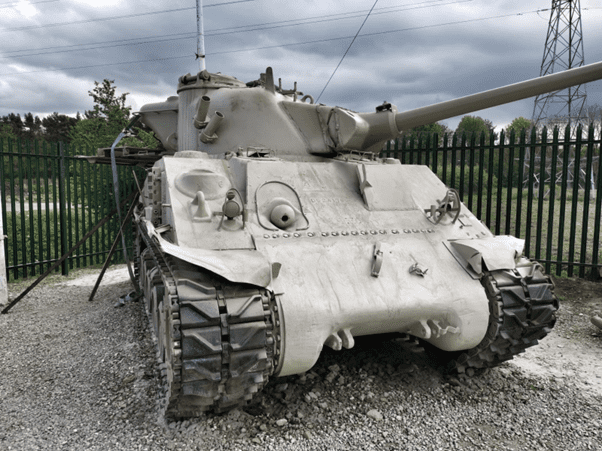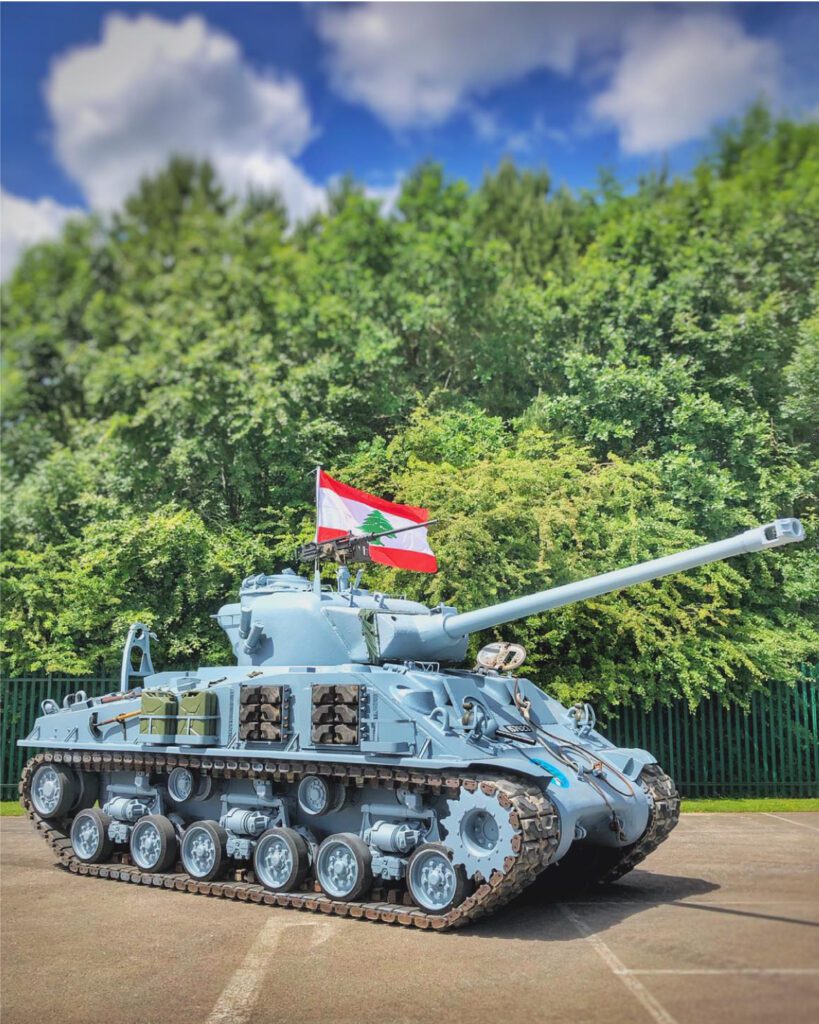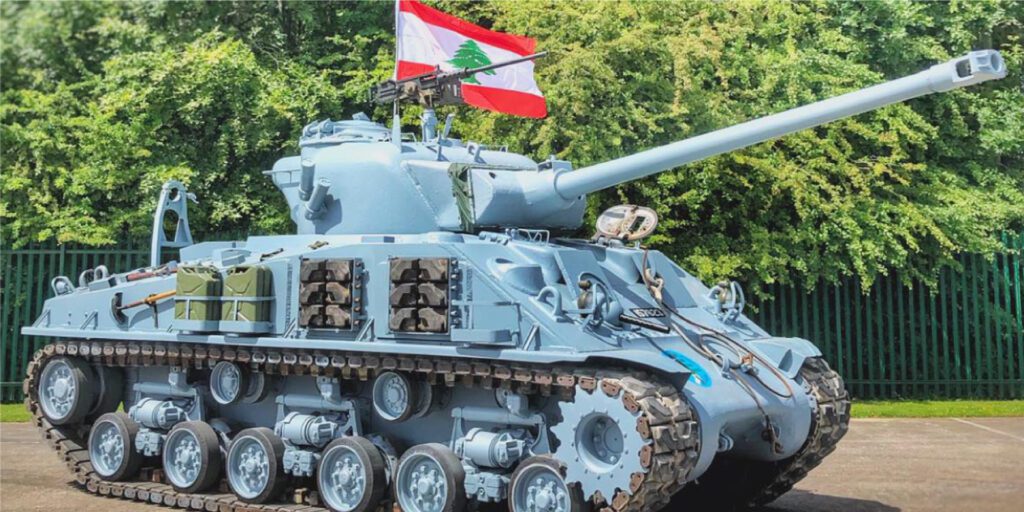A brief history of our M50 Sherman Tank – “MOTHER” – from 1942 to 2019
1942 (original specification)
Using Mother’s serial number, 16565, we can positively identify her as a M4A4 Sherman built by Chrysler in November 1942 at the Chrysler Defence Arsenal. Assigned hood number 3016871, she was originally fitted with a Chrysler A57 multibank engine. This massive 30-cylinder engine, with an output of approximately 370hp, consisted of five 6-cylinder inline engines configured in a star formation. Its massive size required the M4A4 Sherman to be extended by approximately 12” to accommodate it and for the original vertical petrol tanks to be removed leaving only extra-large sponson fuel tanks with a capacity 140 US gallons.

As the M4A4 was almost exclusively shipped to British Forces, under the Lend Lease Agreement, our tank was likely given over to British Forces sometime around 1943 and was assigned a T-Number, a British version of the USA hood number. The reason for suspecting this dating is because the applique armour that appears on the sides of the tank appears and is finished as non-factory; in fact, the welding seems to have been completed with a 2/3mm rod. General history tells us that Chrysler recalled Sherman tanks in 1943 to the factory to be fitted with these applique armour patches. Factory fit and finish would have been completed with larger welding rods , similar to the plate welding that can be seen on the rest of the tank .Therefore it would seem likely that had our applique patches been factory fitted we would see a correlation between welding finishes . This correlation is not present, and we can see the welds are “field welds” using the smaller rod, and in fact the bottom strip on both sides have not been completed. This would suggest that our tank was already in service at the time of the factory recall by Chrysler.
To trace further our tank’s history during WW2, we need to identify the T-number assigned to her by the British when she was accepted by the force. After thorough research and inspection of our tank it would seem our T-number has been lost to time. Unfortunately, there is no correlation between serial number, hood number and T-number and all stamps/plates have been removed post-war, likely by the French or Israelis. It is with regret we must report all WW2 history specific to our tank is unobtainable.
Post-WW2
To understand Mother’s history post-war, we must read her “scars”; the lumps, bumps and welds on our tank. Using the M4A4 specification as a reference point, we notice differences, including:
• a one-piece single cast differential housing: not the 3-part fitted as standard
• weld scars left by the addition of a hull mounted horn, “horn cage” similar to the headlight cages and the addition of a flat plate welded directly to the hull known as a “horn plate”
• a small unassuming hole which had been welded up on the very rear of the tank directly in the centre of the rear armour plate at eye level. This hole corresponds with the fitting of a Continental R975 radial engine. The hole was cut so that a crank handle could be turned several times to ensure the oil from the very bottom of the radial was brought all the way to the top to prevent hydrostatic lock.
An understanding of these marks and their relevance allows us to determine that post-war, our tank became a M4A4T – the T standing for Transforme. The M4A4T programme was a French post-war programme in which France bought equipment from the lend lease programme to re-arm itself following heavy losses during the war. As far as we can tell, Mother saw no action during her time as a M4A4T. Eventually the wartime armaments acquired by France were not required as it began to build its own tanks and weaponry.
1956
1956 was the year that the M4A4T along with other wartime Sherman type tanks were sold in an arms deal between the French and the Israelis, specifically the Israeli Defence Force (IDF). After visiting France to close the deal, the Israelis became interested in the CN75/50 gun as used in AMX 13 French light tanks. France and Israel concluded a deal with France agreeing to produce several prototype tanks for the IDF as part of the agreement, quickly marrying the CN75/50 to the turret and hull of the M4A4T. This was no small undertaking; the level of modification was high. With an extended mantlet and an extra counterweight, the CN75/50 was jimmied into the existing Sherman turret. Upon demonstration of this the IDF was then responsible for the upgrades.
Having secured up to 400 tanks and guns from the French, the IDF upgraded their M4A4T to M50 Sherman Mk1 specification. As the CN75/50 (purportedly developed from a captured panther KWK42 post WW2) was a high velocity gun and almost twice the length of the standard 75mm gun the turret was cut, and a 1500kg counterweight added. The large and somewhat “rough” welds and cuts on Mother’s counterweight along with stamps in Hebrew denoting tension/fuel type etc show that this was an upgrade performed by the IDF.
As the overall weight of the turret increased from 5 tons to approximately 8.5 tons the VVSS proved inadequate. Breakdowns were common and ground displacement, especially on soft sandy ground, became an issue that would render the M50 Mk1 unusable. The solution was for the IDF to copy Sherman technology from WW2 and install HVVS – Horizontal Volute Spring Suspension. This upgrade was achieved by turning the volute spring horizontally to allow the addition of a double set of road wheels allowing the tank to run on 24” track, colloquially referred to as “track and a half”. This took the ground pressure exerted by a standard M4 Sherman on VVSS from 0.927kg/cm to approximately 0.772kg/cm on the new upgraded HVSS. Once again, we can observe the “rough” treatment Mother endured to make this upgrade possible. The hull armour has been cut or gas axed away to allow free access to the added double bogey set which, with the addition of the T80E5 track links, added an extra 4 tons of weight to the tank.
Mother had gone from a M4A4 standard weight of approximately 29 tons to a rather hefty 36.5 tons (approximately) in her M50 configuration; this extra weight now rendering the Continental R975 engine that Mother received under the M4A4T programme inadequate. The IDF replaced the R975 with a Cummins VT8-460 diesel engine. Installing this V configured, 8-cylinder, turbo engine producing 460hp meant that Mother became a M50 Sherman mk2 with the registration mark 813612Y; the “y” is Hebrew denoting that the tank was under the command of the Israeli Army.
General history tells us it was likely early to mid-1950s that the IDF accepted Mother. M50s are widely known to have played a major role in the Six Days War in 1967 and were also used in the Yom Kippur War. A rebuild stamp inside Mother shows that our tank was overhauled by Volcan Industries in 1972, just before the outbreak of the Yom Kippur War 1973.
We have found further dating evidence in the form of inspection stamps on the tank’s fire extinguishers. These dates seem to show the whole career of our tank, assuming they are the original tanks fitted to mother. The Walter Kidde and co tanks show service dates of:
• 11 and 7 1943 (mark unknown)
• 10 1956, (no stamp)
• 10 1966 IDF stamp
• 11 72 TUV stamp – technischer uberwachungsverein (German vehicular inspection company, these stamps also have hand stamps specifications for type, weight full, weight empty and a check see last note in this series)
• 6 1974 IDF
• 4 1980 IDF
• 1982 TUV
• 1 1990 TUV
We can see from these marks that the tank was likely inspected by the Allies (US and UK) in WW2 and then was passed to the IDF in or before 1956. This timeline ties in with its general history. The IDF continued to inspect the tanks from 1956-1980, with help from German/European Allies in 1972, 1982 and 1990. This timeline also correlates to the Allied agreement between the European forces and IDF at this time.
After speaking with members of the IDF while researching Mother, it seems likely that the M50 was no longer used by 1978, having become obsolete. Some were used as checkpoints or static gun emplacements before this date simply “digging in” the tank to create a fortified checkpoint/gun emplacement. With the further advancement of Israel’s armour programme and with the M50 now obsolete, Mother was once again ready to be sold on.
We have been contacted by (Retired) Major Haim Paz of the IDF who remembers our tank directly. Our tank served with the 52nd battalion of the 14th brigade of the IDF. The tank was then transferred to a training school in 1964-65 where Maj Paz was responsible for all tanks. The armour school, in Julies near Askalon, was an ex-British base repurposed as a training school by the IDF. He reported the M50s were well liked by the troops and were very capable.
1980
The IDF allied with a force called the Southern Lebanese Army (SLA). This force was created during the Southern Lebanese Conflict after splitting from the Free Army of Lebanon during the civil war. Some colloquial names for this are Christian Militia and the Free Army of Lebanon. The IDF, as allies, gifted 36 M50 mk2 Shermans to the SLA; one of which was our tank, Mother.
The SLA painted all their armour a distinctive blue colour, to blend with the blue-sky horizon. Mother arrived at Eden Camp in this colour. They did not perform any major upgrades of the M50, only adding a second turret mounted .30cal machine gun (not in every case). Along with every other force, that has been the end user of our M50, the SLA also added their own registration mark. This registration mark remains visible as a scar on Mother and reads “219”. We believe Mother saw action during the Lebanese Conflict 1978-1988, as we can observe, when removing paint layers, different colours of SLA specific schemes. The “rattle can stripe” pattern was only present on SLA armour in the early days of the force, circa 1978-1980. We expect our tank was present during the civil war in Lebanon, and in fact was lost due to a major crash. We have observed severe damage to our tank that would have rendered it unusable, ranging from bent body work, all the way through to broken suspension springs and bent/broken suspension arms.
1988
The SLA put the M50 and various other armour up for sale. A Lebanese buying agent nicknamed “Doobie” who worked with the Budge Collection arranged the sale from the SLA to Budge in winter 1988. 3 SLA M50 (along with other armour M51/M32/M4A1) were purchased, and the shipment arrived from Lebanon into the UK in spring 1989. The Budge collection was a large and successful enterprise and the collection regularly bought several of the same type of vehicle and then picked the very best to be added to the collection – the rest were put up for sale. The shipment was sent from the port of Ashdod, Israel to Goole in the UK. Mother was one of the “less tidy” M50 and she was sold. She arrived at Eden Camp in 1992 where she remained a static display up until 2019. This when the restoration work began…
Tune in for the next blog on how the restoration works went down!



